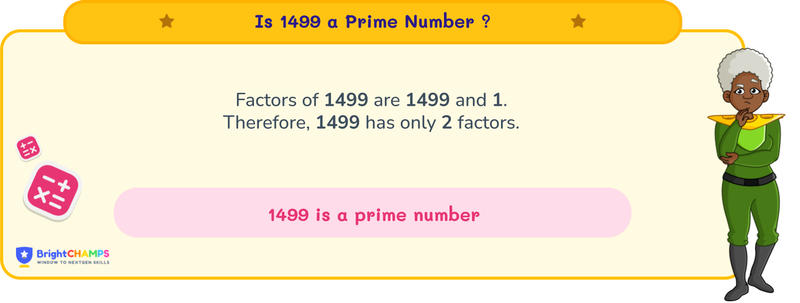Summarize this article:
 259 Learners
259 LearnersLast updated on August 5, 2025
Is 1499 a Prime Number?

A prime number is a natural number greater than 1 that has no positive divisors other than 1 and itself. Prime numbers are fundamental in number theory and have important applications in computer science, cryptography, and mathematics. In this topic, we will be discussing whether 1499 is a prime number or not.

Is 1499 a Prime Number?
Numbers can be classified as prime or composite based on their divisors.
A prime number is a natural number greater than 1 that is divisible only by 1 and itself.
For example, 3 is a prime number because it is divisible by 1 and 3 only.
A composite number has more than two divisors. For instance, 6 is divisible by 1, 2, 3, and 6, making it a composite number.
Prime numbers have specific properties:
- They are greater than 1.
- 2 is the only even prime number.
- They have exactly two distinct positive divisors: 1 and the number itself.
- Any two distinct prime numbers are co-prime because they share no common divisors other than 1.
- Since 1499 has exactly two distinct divisors, 1 and 1499, it is a prime number.


Why is 1499 a Prime Number?
The defining characteristic of a prime number is that it has exactly two distinct divisors: 1 and the number itself. Since 1499 has no divisors other than 1 and 1499, it is a prime number. Several methods can be used to determine whether a number is prime or composite, such as:
- Counting Divisors Method
- Divisibility Test
- Prime Number Chart
- Prime Factorization

Using the Counting Divisors Method
The counting divisors method involves counting the number of divisors a number has to determine if it is prime or composite.
- If there are exactly 2 divisors, the number is prime.
- If there are more than 2 divisors, the number is composite.
Let's verify whether 1499 is prime or composite:
Step 1: Every number is divisible by 1 and itself.
Step 2: Check divisibility from 2 up to the square root of 1499.
Since 1499 is not divisible by any number other than 1 and itself, it has only 2 divisors and is, therefore, a prime number.
Explore Our Programs



Using the Divisibility Test Method
The divisibility test involves checking if a number can be divided evenly by another number. Here are some tests applied to 1499:
Divisibility by 2: 1499 is odd and not divisible by 2.
Divisibility by 3: The sum of the digits of 1499 is 23, which is not divisible by 3.
Divisibility by 5: 1499 does not end in 0 or 5, so it is not divisible by 5.
Divisibility by other primes (e.g., 7, 11, 13): Testing these shows that 1499 is not divisible by any of them.
Since 1499 is not divisible by any of these, it remains a prime number.

Using Prime Number Chart
A prime number chart, often created using the Sieve of Eratosthenes, can help identify prime numbers. The process involves:
Step 1: List numbers from 1 to a certain limit.
Step 2: Cross out 1, as it is neither prime nor composite.
Step 3: Mark 2 as prime and cross out all multiples of 2.
Step 4: Mark 3 as prime and cross out all multiples of 3.
Step 5: Continue the process for subsequent numbers. Although 1499 is beyond typical chart limits, it can be checked using this method to confirm prime status.
Since 1499 cannot be crossed out as a multiple of a smaller prime, it is a prime number.

Using the Prime Factorization Method

Common Mistakes to Avoid When Determining if 1499 is a Prime Number
Misunderstandings about prime numbers can lead to mistakes. Here are some common errors:

FAQ on Is 1499 a Prime Number?
1.Is 1499 a perfect square?
2.What is the sum of the divisors of 1499?
3.What are the factors of 1499?
4.What are the closest prime numbers to 1499?
5.What is the prime factorization of 1499?

Important Glossaries for "Is 1499 a Prime Number"
- Prime Numbers: Natural numbers greater than 1 with no divisors other than 1 and themselves. For example, 1499 is a prime number.
- Composite Numbers: Numbers with more than two distinct positive divisors. For example, 12 is a composite number.
- Divisibility Test: A method to determine if one number is divisible by another without a remainder.
- Sieve of Eratosthenes: An ancient algorithm used to find all prime numbers up to a specified integer.
- Prime Factorization: The process of breaking down a number into its prime number components.



Hiralee Lalitkumar Makwana
About the Author
Hiralee Lalitkumar Makwana has almost two years of teaching experience. She is a number ninja as she loves numbers. Her interest in numbers can be seen in the way she cracks math puzzles and hidden patterns.
Fun Fact
: She loves to read number jokes and games.

















